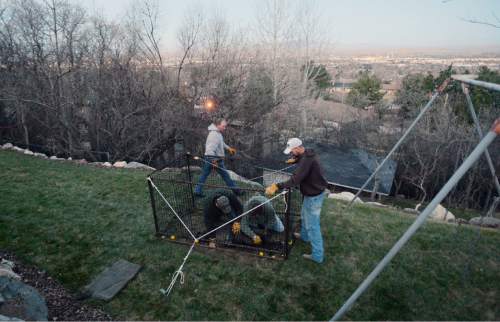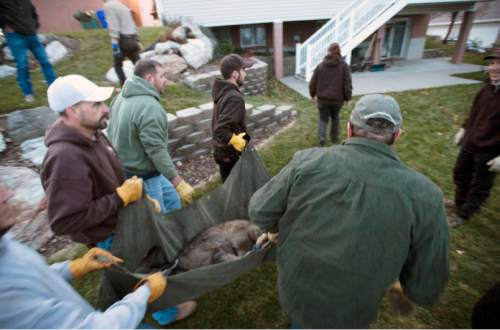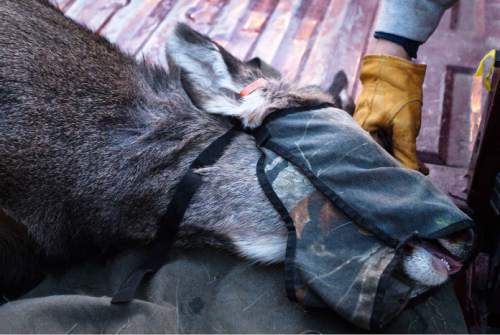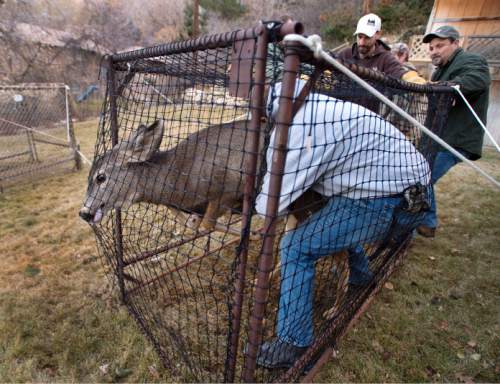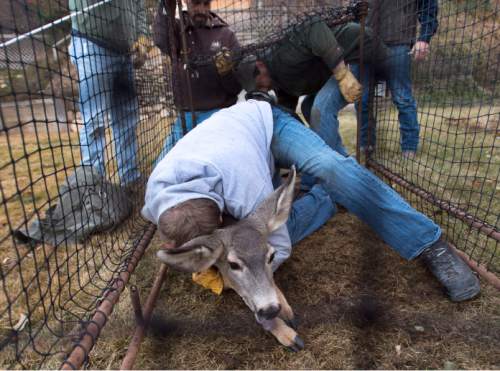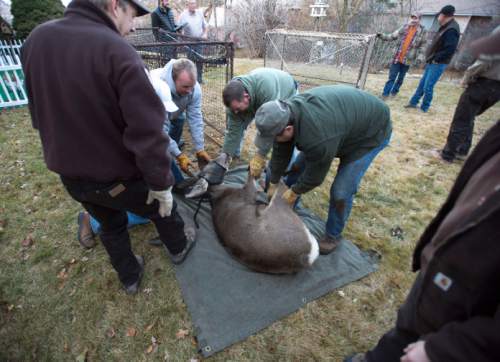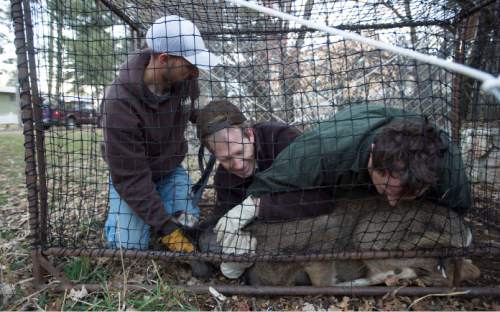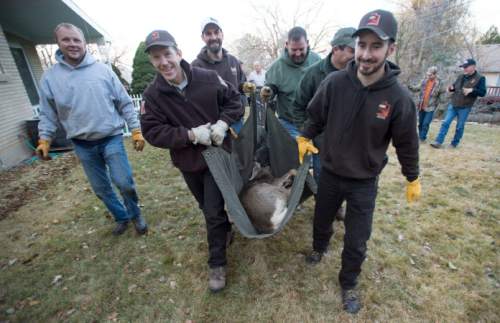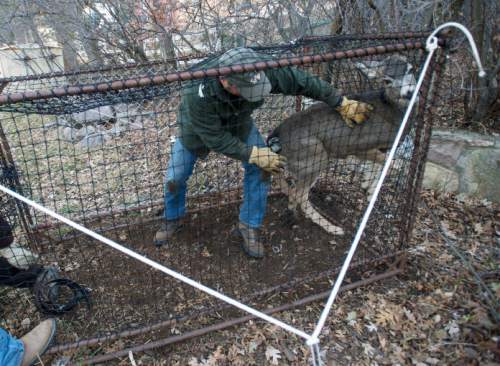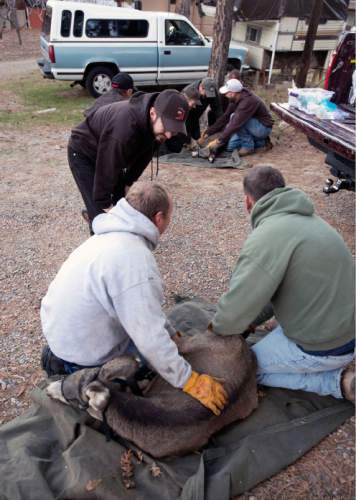Steve Griffin | The Salt Lake Tribune
Volunteers subdue a mule deer that was caught in a trap in a neighborhood above Bountiful
Steve Griffin | The Salt Lake Tribune
Volunteers Kurt Wood and Sean Larsen subdue a mule deer that was caught in a trap in a ne
Steve Griffin | The Salt Lake Tribune
Volunteers and DWR employees carry a mule deer that was caught in a trap in a neighborho
Steve Griffin | The Salt Lake Tribune
A mule deer that was caught in a trap in a neighborhood above Bountiful, Utah Friday, De
Steve Griffin | The Salt Lake Tribune
Volunteer Tyler Cella wrestles a mule deer doe to the ground that was caught in a trap in
Steve Griffin | The Salt Lake Tribune
Volunteer Tyler Cella pushes a mule deer doe into the front of the trap so he can subdue
Steve Griffin | The Salt Lake Tribune
Volunteer Tyler Cella uses his weight to subdue a mule deer doe that was caught in a trap
Steve Griffin | The Salt Lake Tribune
Volunteer Tyler Cella uses his weight to subdue a mule deer doe that was caught in a trap
Steve Griffin | The Salt Lake Tribune
Volunteers and DWR employees place a mule deer that was caught in a trap, in a neighborho
Steve Griffin | The Salt Lake Tribune
Volunteer Kurt Wood, right, and DWR director of wildlife resources Greg Sheehan, use thei
Steve Griffin | The Salt Lake Tribune
DWR urban wildlife specialist Channing Howard gentle looks at the teeth of a mule deer th
Steve Griffin | The Salt Lake Tribune
Volunteers and DWR employees carry a mule deer that was caught in a trap in a neighborho
Steve Griffin | The Salt Lake Tribune
Volunteer Kurt Wood pushes a mule deer into the front of the trap so he can subdue it as
Steve Griffin | The Salt Lake Tribune
DWR employees and volunteers administer to mule deer that were caught in traps in a neigh
Steve Griffin | The Salt Lake Tribune
Three mule deer watch from a neighborhood above Bountiful, Utah Friday, December 12, 2014
Steve Griffin | The Salt Lake Tribune
Volunteers subdue a mule deer that was caught in a trap in a neighborhood above Bountiful, Utah Friday, December 12, 2014. The Utah Division of Wildlife Resources is trapping mule deer in Bountiful City in an effort to reduce the urban population and reduce human/wildlife conflicts. They set traps and bait them. The deer trigger the trap. The deer are collared and checked for disease before being sent to other parts of the state. These deer are headed to the Raft River Mountains in northwestern Utah.
Steve Griffin | The Salt Lake Tribune
Volunteers Kurt Wood and Sean Larsen subdue a mule deer that was caught in a trap in a neighborhood above Bountiful, Utah Friday, December 12, 2014. The Utah Division of Wildlife Resources is trapping mule deer in Bountiful City in an effort to reduce the urban population and reduce human/wildlife conflicts. They set traps and bait them. The deer trigger the trap. The deer are collared and checked for disease before being sent to other parts of the state. These deer are headed to the Raft River Mountains in northwestern Utah.
Steve Griffin | The Salt Lake Tribune
Volunteers and DWR employees carry a mule deer that was caught in a trap in a neighborhood above Bountiful, Utah Friday, December 12, 2014. The Utah Division of Wildlife Resources is trapping mule deer in Bountiful City in an effort to reduce the urban population and reduce human/wildlife conflicts. They set traps and bait them. The deer trigger the trap. The deer are collared and checked for disease before being sent to other parts of the state. These deer are headed to the Raft River Mountains in northwestern Utah.
Steve Griffin | The Salt Lake Tribune
A mule deer that was caught in a trap in a neighborhood above Bountiful, Utah Friday, December 12, 2014 is administered to by DWR employees. The Utah Division of Wildlife Resources is trapping mule deer in Bountiful City in an effort to reduce the urban population and reduce human/wildlife conflicts. They set traps and bait them. The deer trigger the trap. The deer are collared and checked for disease before being sent to other parts of the state. These deer are headed to the Raft River Mountains in northwestern Utah.
Steve Griffin | The Salt Lake Tribune
Volunteer Tyler Cella wrestles a mule deer doe to the ground that was caught in a trap in a neighborhood above Bountiful, Utah Friday, December 12, 2014. The Utah Division of Wildlife Resources is trapping mule deer in Bountiful City in an effort to reduce the urban population and reduce human/wildlife conflicts. They set traps and bait them. The deer trigger the trap. The deer are collared and checked for disease before being sent to other parts of the state. These deer are headed to the Raft River Mountains in northwestern Utah.
Steve Griffin | The Salt Lake Tribune
Volunteer Tyler Cella pushes a mule deer doe into the front of the trap so he can subdue it as fellow volunteers Sean Larsen, Lonne Rasmussen and Kurt Wood prepare to enter the trap in a neighborhood above Bountiful, Utah Friday, December 12, 2014. The Utah Division of Wildlife Resources is trapping mule deer in Bountiful City in an effort to reduce the urban population and reduce human/wildlife conflicts. They set traps and bait them. The deer trigger the trap. The deer are collared and checked for disease before being sent to other parts of the state. These deer are headed to the Raft River Mountains in northwestern Utah.
Steve Griffin | The Salt Lake Tribune
Volunteer Tyler Cella uses his weight to subdue a mule deer doe that was caught in a trap in a neighborhood above Bountiful, Utah Friday, December 12, 2014. Fellow volunteers Sean Larsen, Lonne Rasmussen and Kurt Wood enter the trap after the deer is subdued and hobble and blindfold the animal to calm it down. The Utah Division of Wildlife Resources is trapping mule deer in Bountiful City in an effort to reduce the urban population and reduce human/wildlife conflicts. They set traps and bait them. The deer trigger the trap. The deer are collared and checked for disease before being sent to other parts of the state. These deer are headed to the Raft River Mountains in northwestern Utah.
Steve Griffin | The Salt Lake Tribune
Volunteer Tyler Cella uses his weight to subdue a mule deer doe that was caught in a trap in a neighborhood above Bountiful, Utah Friday, December 12, 2014. Fellow volunteers Sean Larsen, Lonne Rasmussen and Kurt Wood enter the trap after the deer is subdued and hobble and blindfold the animal to calm it down. The Utah Division of Wildlife Resources is trapping mule deer in Bountiful City in an effort to reduce the urban population and reduce human/wildlife conflicts. They set traps and bait them. The deer trigger the trap. The deer are collared and checked for disease before being sent to other parts of the state. These deer are headed to the Raft River Mountains in northwestern Utah.
Steve Griffin | The Salt Lake Tribune
Volunteers and DWR employees place a mule deer that was caught in a trap, in a neighborhood above Bountiful, Utah Friday, December 12, 2014, onto a tarp so they can carry it to a trailer. The Utah Division of Wildlife Resources is trapping mule deer in Bountiful City in an effort to reduce the urban population and reduce human/wildlife conflicts. They set traps and bait them. The deer trigger the trap. The deer are collared and checked for disease before being sent to other parts of the state. These deer are headed to the Raft River Mountains in northwestern Utah.
Steve Griffin | The Salt Lake Tribune
Volunteer Kurt Wood, right, and DWR director of wildlife resources Greg Sheehan, use their weight to subdue a mule deer as volunteer Lonne Rasmussen, left, prepares to hobble and blindfold the animal that was trapped in a neighborhood above Bountiful, Utah Friday, December 12, 2014. The Utah Division of Wildlife Resources is trapping mule deer in Bountiful City in an effort to reduce the urban population and reduce human/wildlife conflicts. They set traps and bait them. The deer trigger the trap. The deer are collared and checked for disease before being sent to other parts of the state. These deer are headed to the Raft River Mountains in northwestern Utah.
Steve Griffin | The Salt Lake Tribune
DWR urban wildlife specialist Channing Howard gentle looks at the teeth of a mule deer that was caught in a trap in a neighborhood above Bountiful, Utah Friday, December 12, 2014. The Utah Division of Wildlife Resources is trapping mule deer in Bountiful City in an effort to reduce the urban population and reduce human/wildlife conflicts. They set traps and bait them. The deer trigger the trap. The deer are collared and checked for disease before being sent to other parts of the state. These deer are headed to the Raft River Mountains in northwestern Utah.
Steve Griffin | The Salt Lake Tribune
Volunteers and DWR employees carry a mule deer that was caught in a trap in a neighborhood above Bountiful, Utah Friday, December 12, 2014. The Utah Division of Wildlife Resources is trapping mule deer in Bountiful City in an effort to reduce the urban population and reduce human/wildlife conflicts. They set traps and bait them. The deer trigger the trap. The deer are collared and checked for disease before being sent to other parts of the state. These deer are headed to the Raft River Mountains in northwestern Utah.
Steve Griffin | The Salt Lake Tribune
Volunteer Kurt Wood pushes a mule deer into the front of the trap so he can subdue it as fellow volunteers Sean Larsen, Lonne Rasmussen and Tyler Cella prepare to enter the trap in a neighborhood above Bountiful, Utah Friday, December 12, 2014. The Utah Division of Wildlife Resources is trapping mule deer in Bountiful City in an effort to reduce the urban population and reduce human/wildlife conflicts. They set traps and bait them. The deer trigger the trap. The deer are collared and checked for disease before being sent to other parts of the state. These deer are headed to the Raft River Mountains in northwestern Utah.
Steve Griffin | The Salt Lake Tribune
DWR employees and volunteers administer to mule deer that were caught in traps in a neighborhood above Bountiful, Utah Friday, December 12, 2014. The Utah Division of Wildlife Resources is trapping mule deer in Bountiful City in an effort to reduce the urban population and reduce human/wildlife conflicts. They set traps and bait them. The deer trigger the trap. The deer are collared and checked for disease before being sent to other parts of the state. These deer are headed to the Raft River Mountains in northwestern Utah.
Steve Griffin | The Salt Lake Tribune
Three mule deer watch from a neighborhood above Bountiful, Utah Friday, December 12, 2014. The Utah Division of Wildlife Resources is trapping mule deer in Bountiful City in an effort to reduce the urban population and reduce human/wildlife conflicts. They set traps and bait them. The deer trigger the trap. The deer are collared and checked for disease before being sent to other parts of the state. These deer are headed to the Raft River Mountains in northwestern Utah.


